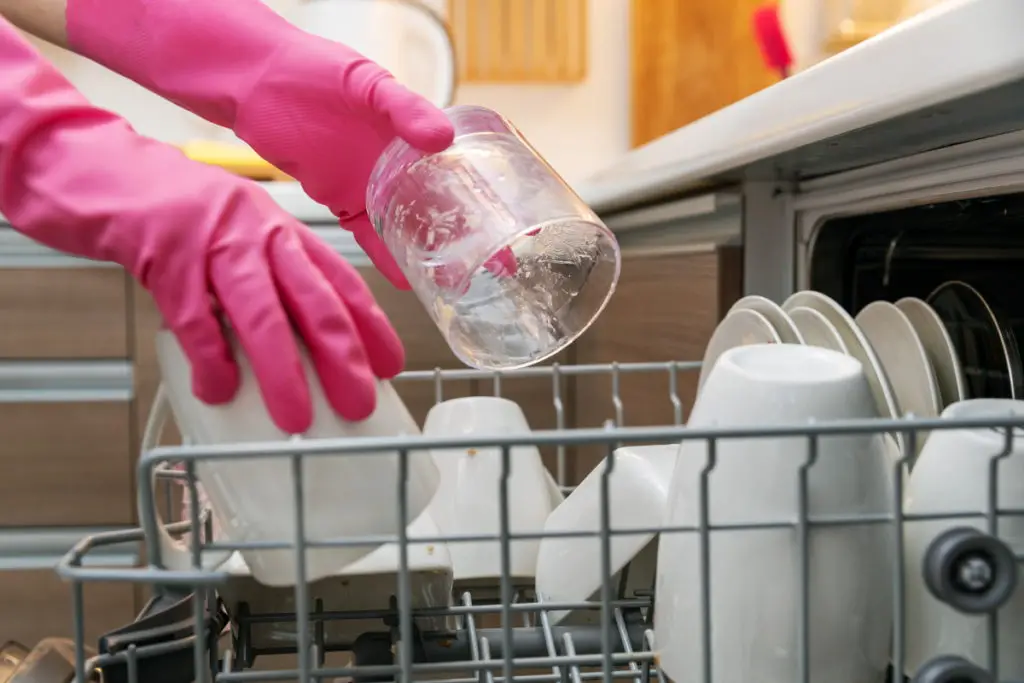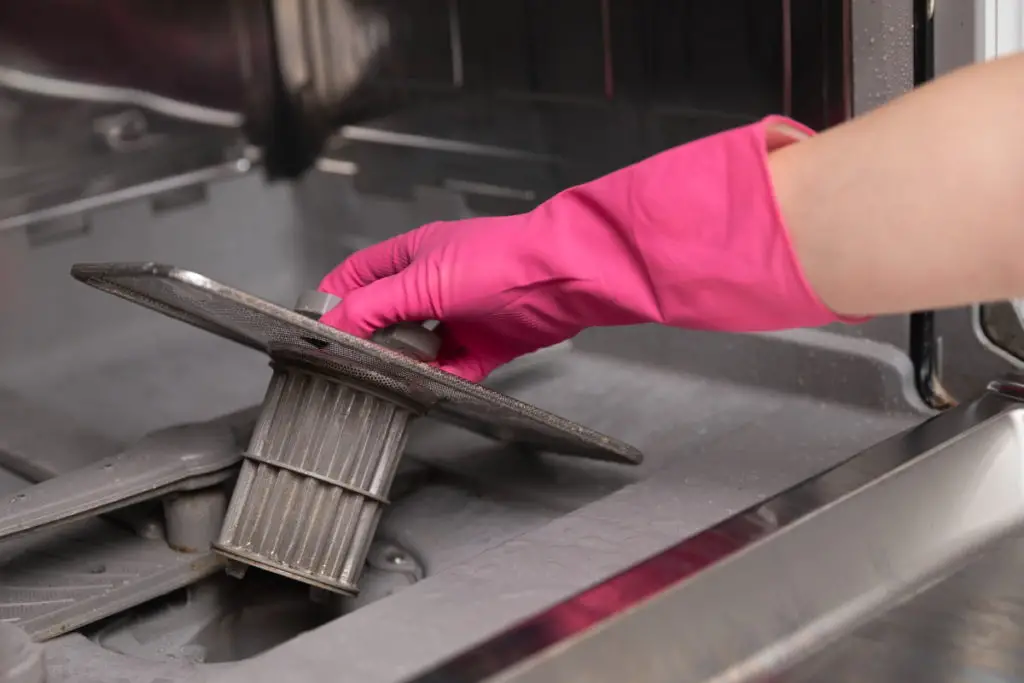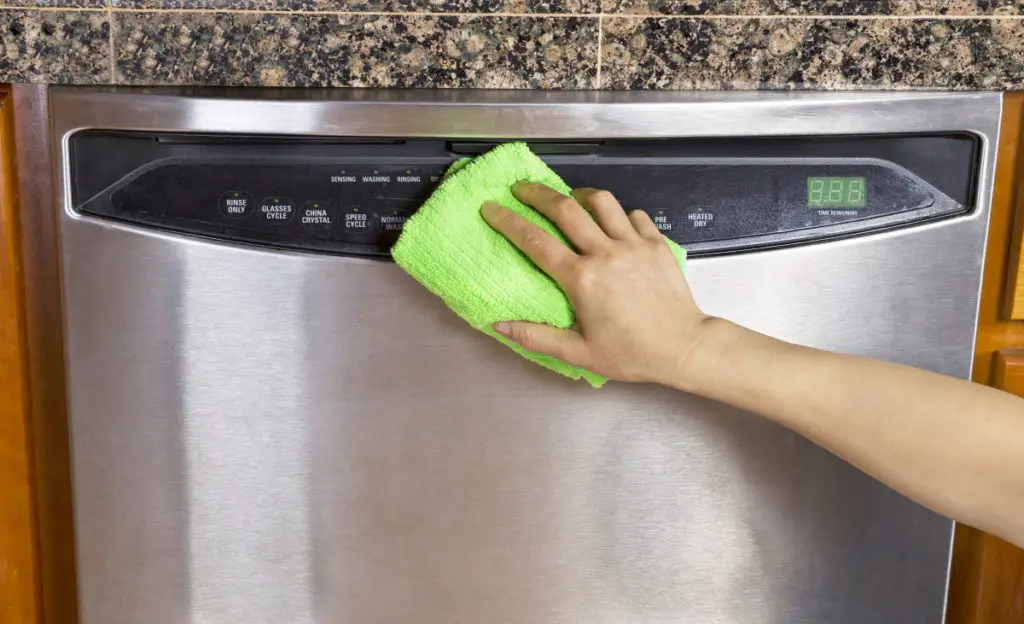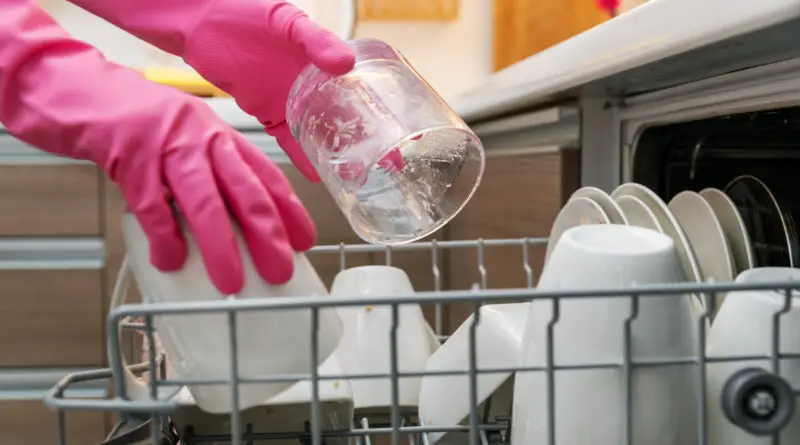How to Clean Your Dishwasher

Like any machine in your household, a dishwasher needs regular maintenance, and by that, I mean you need to clean it at least once a month. Let’s not pretend that cleaning a dishwasher may seem a bit redundant, and perhaps many of you avoid doing it, thinking it’s cleaning itself every time you turn it on.
But what most of you don’t realize is that food residue, soap scum, and grease, accumulate in your dishwasher no matter how many times you have used it.
You may not be able to see it, but that doesn’t mean you should skip cleaning your dishwasher on a regular basis.
The worst part is that if you don’t clean your dishwasher, this grimy build-up will start smelling bad. And, will reduce your dishwasher’s efficiency.
So, the next time you smell those musty odors, or you see a dirty dish after your dishwasher has finished a full cycle, you will know what to do.
By comparison, cleaning a dishwasher is nothing like cleaning your stove or your bathtub. It’s very easy to do! And the best part of all is, it only takes a few minutes of your time.
So, here are 5 easy tips to follow for a fast-cleaning procedure to make your dishwasher clean your dishes effectively.
1. Frequency: Once per month
Regardless of whether you have a new dishwasher or an older one, take the time to clean it once a month. Remember to include the drain and the filter.
Food particles that haven’t been removed from dishes before placing them in the dishwasher are the most common reason drains and spray arms get clogged.
And when that happens, it reduces the amount of water needed for the rinse and wash cycle. This is a reason your glasses and dishes may end up cloudy and gritty.
Additionally, irregular cleaning can result in your dishwasher starting to smell and dishes with soap residue after a full cycle.
So, the best way to keep dishes clean is to clean your dishwasher once a month. Deep clean the interior, clean the filter, drain, dishwasher door, top and bottom racks, and the exterior of your appliance. Not only will you have clean dishes, but you may extend the life of your dishwasher.
2. Focus: Interior
More often than not, we don’t think of cleaning the dishwasher after it has finished a full wash cycle. But food particles can’t be dissolved, and we can’t make them disappear, so eventually, your dishwasher will become a garbage disposal, if not cleaned regularly.
Clean the door interior
Start cleaning the door from the inside. Using a damp cloth or sponge, thoroughly clean the surface of the interior, door edges, handle, and dishwasher button and controls. Ensure that the rubber seal around the door is cleaned as well as around the hinge, as it is prone to build-up.
How to clean the dishwasher drain
Remove the bottom rack. Remove any leftover food you see or anything else that may clog the drain. Mix 1 tablespoon of baking soda and 2 tablespoons of vinegar, and pour it down the drain. This will remove any additional grease or soap scum from the drain. You can use a commercial drain cleaner if you prefer, but some might be harsh on your dishwasher, so make sure you check your owner’s manual first.
Cleaning the filter

Filters need to be either cleaned or replaced. If the filter is clogged, your dishwasher will not clean efficiently. To find the filter, look at the bottom of your dishwasher, just under the spray arm. It takes only 5 minutes to clean your dishwasher filter thoroughly, and you are free to go about your day. Here are the steps:
- Remove the filter and rinse with running hot water
- Using a soft-bristle brush, remove all remaining bits of food
- You can use distilled white vinegar and baking soda to soak the filter in or use a commercial cleaner
- Put the filter back into place
If you are still not sure how to clean and what to clean your filter with, check the owner’s manual.
Cleaning the top rack
First, check your upper spray arm and look for clogged holes. Or you may have blocked it with a pot or a tall utensil. So, make sure the upper spray arm is unobstructed. Using a piece of wire, or a toothpick clean out the holes. Alternatively, remove the upper arm spray and soak it in the vinegar and baking soda mix or other commercial lime cleaners, as per the manufacturer’s instructions. This will get rid of any mineral deposits if you have hard water.
Bottom rack
The next step to removing unwanted food particles is to pull out the bottom rack. You will likely find bits of food left behind. Remove them with a paper towel to prevent further buildup. Soak in vinegar and baking soda mix if you prefer.
3. Cleaning Products: Natural
One way to use natural products to deep clean the inside of your dishwasher is using a white vinegar and baking soda combination. Here are the steps:
- Place one cup of vinegar in the middle of the top rack
- Run a full wash cycle on the hottest setting
- Sprinkle one cup of baking soda all over the bottom of the dishwasher and run your dishwasher again but this time on a short hot-water cycle
The vinegar will help loosen grease and soap scum and will wash them down the drain while the baking soda will get rid of stains and musty odors.
Cleaning the utensil holder:
- Make a mixture of warm water and a cup of white vinegar in your sink
- Soak the utensil holders, and filter, for 30 minutes
4. Cleaning Products: Commercial
If you prefer to use commercial cleaning products to clean your dishwasher, keep these few things in mind. First, read the label carefully to confirm the product is safe to use on dishwashers. Second, follow the directions on the label exactly – using too much of the product can damage your dishwasher. Finally, rinse any residue from the cleaning product before running a cycle.
5. Clean the Exterior

Finally, after you have deep cleaned the inside of the dishwasher, close the door, and using a damp cloth or sponge, wipe it down along the direction of the stainless steel grain, if your dishwasher is stainless steel.
(i) Remove food
Using a wet cloth, gently remove any excess materials like bits of food and grease from the surface of your appliance.
For dried-on food that is more difficult to remove, mix baking soda and warm water, and gently wipe the area with a clean cloth, using the other side of the cloth to remove the residue.
(ii) Cleaner
Using your cleaner of choice, clean the surface in good, long swipes following the grain of the stainless steel. Wipe down the surfaces, nooks, and crannies of the appliances. Follow this up with a complete rinse, making sure no spot is left with cleaner. After the rinse, dry the appliance completely with a dry microfiber cloth.
(iii) Polish
You can add shine to your appliance by buffing the surface with a little olive oil. You won’t need a lot to give your stainless steel dishwasher that brand-new look.
Ultimately, you have to make it a habit to rinse and wipe the remaining bits of food from the plates, before loading them into the dishwasher. Labels are another thing to keep an eye on. Remove labels, paper, or barcodes on new items before putting them in the dishwasher.
See How to Clean Stainless Steel Appliances for more details.
Recap
Keeping a clean dishwasher is important to keep your dishwasher smelling fresh, and your dishes and glasses looking clean.
Maintaining a monthly schedule Is a good target to aim for. Remember the following points:
- Clean the door’s interior
- Clean the dishwasher drain by removing any food scraps and flushing with a baking soda and vinegar mix
- Clean the filter
- Clean the top and bottom racks
- Clean the bottom of the machine by removing any food debris
- Run a cleaning cycle with vinegar to remove grimy buildup and another cycle with baking soda to get rid of stains and odors
- Soak utensil holder in vinegar for 30 minutes
- Clean and wipe down the exterior of the dishwasher
So, if you’re like most people and rely on your dishwasher to keep your dishes clean and bacteria-free, be sure to take the time every month to give it a good cleaning! By following these simple steps, you can keep your dishwasher running smoothly, and your dishes will be clean and bacteria-free.
